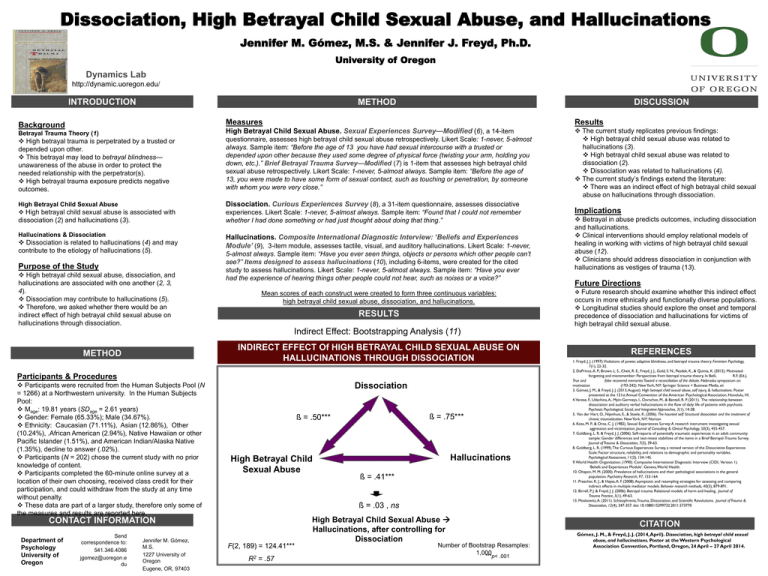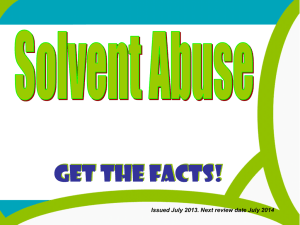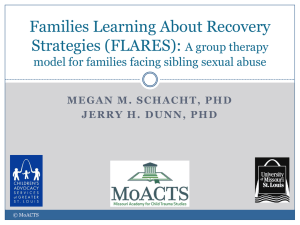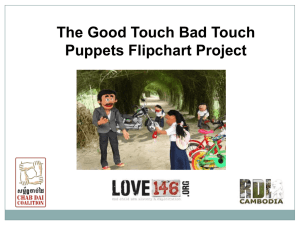
Dissociation, High Betrayal Child Sexual Abuse, and Hallucinations
Jennifer M. Gómez, M.S. & Jennifer J. Freyd, Ph.D.
University of Oregon
Dynamics Lab
http://dynamic.uoregon.edu/
INTRODUCTION
METHOD
Background
Betrayal Trauma Theory (1)
DISCUSSION
Measures
Results
High Betrayal Child Sexual Abuse. Sexual Experiences Survey—Modified (6), a 14-item
The current study replicates previous findings:
High betrayal child sexual abuse was related to
hallucinations (3).
High betrayal child sexual abuse was related to
dissociation (2).
Dissociation was related to hallucinations (4).
The current study’s findings extend the literature:
There was an indirect effect of high betrayal child sexual
abuse on hallucinations through dissociation.
High betrayal trauma is perpetrated by a trusted or
depended upon other.
This betrayal may lead to betrayal blindness—
unawareness of the abuse in order to protect the
needed relationship with the perpetrator(s).
High betrayal trauma exposure predicts negative
outcomes.
questionnaire, assesses high betrayal child sexual abuse retrospectively. Likert Scale: 1-never, 5-almost
always. Sample item: “Before the age of 13, you have had sexual intercourse with a trusted or
depended upon other because they used some degree of physical force (twisting your arm, holding you
down, etc.).” Brief Betrayal Trauma Survey—Modified (7) is 1-item that assesses high betrayal child
sexual abuse retrospectively. Likert Scale: 1-never, 5-almost always. Sample item: “Before the age of
13, you were made to have some form of sexual contact, such as touching or penetration, by someone
with whom you were very close.”
High Betrayal Child Sexual Abuse
High betrayal child sexual abuse is associated with
Dissociation. Curious Experiences Survey (8), a 31-item questionnaire, assesses dissociative
dissociation (2) and hallucinations (3).
Hallucinations & Dissociation
Dissociation is related to hallucinations (4) and may
contribute to the etiology of hallucinations (5).
Purpose of the Study
High betrayal child sexual abuse, dissociation, and
hallucinations are associated with one another (2, 3,
4).
Dissociation may contribute to hallucinations (5).
Therefore, we asked whether there would be an
indirect effect of high betrayal child sexual abuse on
hallucinations through dissociation.
experiences. Likert Scale: 1-never, 5-almost always. Sample item: “Found that I could not remember
whether I had done something or had just thought about doing that thing.”
Hallucinations. Composite International Diagnostic Interview: ‘Beliefs and Experiences
Module’ (9), 3-item module, assesses tactile, visual, and auditory hallucinations. Likert Scale: 1-never,
5-almost always. Sample item: “Have you ever seen things, objects or persons which other people can’t
see?” Items designed to assess hallucinations (10), including 6-items, were created for the cited
study to assess hallucinations. Likert Scale: 1-never, 5-almost always. Sample item: “Have you ever
had the experience of hearing things other people could not hear, such as noises or a voice?”
Mean scores of each construct were created to form three continuous variables:
high betrayal child sexual abuse, dissociation, and hallucinations.
RESULTS
Implications
Betrayal in abuse predicts outcomes, including dissociation
and hallucinations.
Clinical interventions should employ relational models of
healing in working with victims of high betrayal child sexual
abuse (12).
Clinicians should address dissociation in conjunction with
hallucinations as vestiges of trauma (13).
Future Directions
Future research should examine whether this indirect effect
occurs in more ethnically and functionally diverse populations.
Longitudinal studies should explore the onset and temporal
precedence of dissociation and hallucinations for victims of
high betrayal child sexual abuse.
Indirect Effect: Bootstrapping Analysis (11)
INDIRECT EFFECT Of HIGH BETRAYAL CHILD SEXUAL ABUSE ON
HALLUCINATIONS THROUGH DISSOCIATION
METHOD
Participants & Procedures
Participants were recruited from the Human Subjects Pool (N
= 1266) at a Northwestern university. In the Human Subjects
Pool:
Mage: 19.81 years (SDage = 2.61 years)
Gender: Female (65.33%); Male (34.67%).
Ethnicity: Caucasian (71.11%), Asian (12.86%), Other
(10.24%), .African American (2.94%), Native Hawaiian or other
Pacific Islander (1.51%), and American Indian/Alaska Native
(1.35%), decline to answer (.02%).
Participants (N = 202) chose the current study with no prior
knowledge of content.
Participants completed the 60-minute online survey at a
location of their own choosing, received class credit for their
participation, and could withdraw from the study at any time
without penalty.
These data are part of a larger study, therefore only some of
the measures and results are reported here.
Dissociation
High Betrayal Child
Sexual Abuse
Department of
Psychology
University of
Oregon
Jennifer M. Gómez,
M.S.
1227 University of
Oregon
Eugene, OR, 97403
Hallucinations
ß = .41***
ß = .03 , ns
CONTACT INFORMATION
Send
correspondence to:
541.346.4086
jgomez@uoregon.e
du
ß = .75***
ß = .50***
F(2, 189) = 124.41***
R2
= .57
High Betrayal Child Sexual Abuse
Hallucinations, after controlling for
Dissociation
REFERENCES
1. Freyd, J. J. (1997). Violations of power, adaptive blindness, and betrayal trauma theory. Feminism Psychology,
7(1), 22-32.
2. DePrince, A. P., Brown, L. S., Cheit, R. E., Freyd, J. J., Gold, S. N., Pezdek, K., & Quinta, K. (2012). Motivated
forgetting and misremember: Perspectives from betrayal trauma theory. In Belli,
R.F. (Ed.),
True and
false recovered memories: Toward a reconciliation of the debate. Nebraska symposium on
motivation
(193-242). New York, NY: Springer Science + Business Media, xii
3. Gómez, J. M., & Freyd, J. J. (2013, August). High betrayal child sexual abuse, self injury, & hallucinations. Poster
presented at the 121st Annual Convention of the American Psychological Association, Honolulu, HI.
4.Varese, F., Udachina, A., Myin-Germeys, I., Oorschot, M., & Bentall, R. P. (2011). The relationship between
dissociation and auditory verbal hallucinations in the flow of daily life of patients with psychosis.
Psychosis: Psychological, Social, and Integrative Approaches, 3(1), 14-28.
5. Van der Hart, O., Nijenhuis, E., & Steele, K. (2006). The haunted self: Structural dissociation and the treatment of
chronic traumatization. New York, NY: Norton
6. Koss, M. P., & Oros, C. J. (1982). Sexual Experiences Survey: A research instrument investigating sexual
aggression and victimization. Journal of Consulting & Clinical Psychology, 50(3), 455-457.
7. Goldberg, L. R. & Freyd, J. J. (2006). Self-reports of potentially traumatic experiences in an adult community
sample: Gender differences and test-retest stabilities of the items in a Brief Betrayal-Trauma Survey.
Journal of Trauma & Dissociation, 7(3), 39-63.
8. Goldberg, L. R. (1999). The Curious Experiences Survey, a revised version of the Dissociative Experiences
Scale: Factor structure, reliability, and relations to demographic and personality variables.
Psychological Assessment, 11(2), 134-145.
9. World Health Organization. (1990). Composite International Diagnostic Interview (CIDI, Version 1).
‘Beliefs and Experiences Module’. Geneva, World Health.
10. Ohayon, M. M. (2000). Prevalence of hallucinations and their pathological associations in the general
population. Psychiatry Research, 97, 153-164.
11. Preacher, K. J., & Hayes, A. F. (2008). Asymptotic and resampling strategies for assessing and comparing
indirect effects in multiple mediator models. Behavior research methods, 40(3), 879-891.
12. Birrell, P. J. & Freyd, J. J. (2006). Betrayal trauma: Relational models of harm and healing. Journal of
Trauma Practice, 5(1), 49-63.
13. Moskowitz, A. (2011). Schizophrenia, Trauma, Dissociation, and Scientific Revolutions. Journal of Trauma &
Dissociation, 12(4), 347-357. doi: 10.1080/15299732.2011.573770
CITATION
Number of Bootstrap Resamples:
1,000
***p< .001
Gómez, J. M., & Freyd, J. J. (2014, April). Dissociation, high betrayal child sexual
abuse, and hallucinations. Poster at the Western Psychological
Association Convention, Portland, Oregon, 24 April – 27 April 2014.










